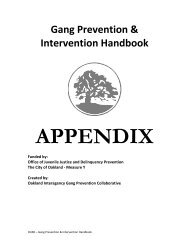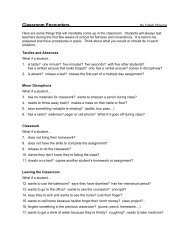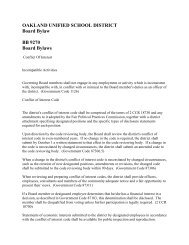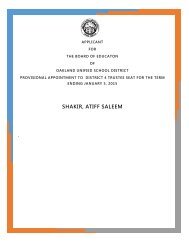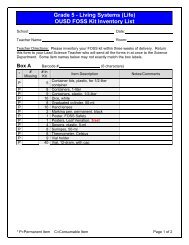Bullying Information a. Data on School Safety * b.
Bullying Information a. Data on School Safety * b.
Bullying Information a. Data on School Safety * b.
You also want an ePaper? Increase the reach of your titles
YUMPU automatically turns print PDFs into web optimized ePapers that Google loves.
Tier Two -‐ INTERVENTION Three Tier Approach to <strong>School</strong> <strong>Safety</strong> Resp<strong>on</strong>ding and investigating to specific incident of bullying and harassment. Example; provide (a) training and support for adults specific problems—bullying preventi<strong>on</strong>, (b) training and support for youth to assist in addressing specific problem behaviors, (c) re-‐teach or affirm a specific pro-‐social skills, and (d) provide small group interventi<strong>on</strong> aimed at a specific skill sets. When an incident occurs communicate and coordinate interventi<strong>on</strong> strategies with support staff, mental health specialist, family members, and other invested pers<strong>on</strong>s. ________________________________________________________________________ As needed, create a behavior c<strong>on</strong>tract with student, teacher, parent and administrators to explicitly outline appropriate behavior and c<strong>on</strong>sequences. ________________________________________________________________________ Develop an acti<strong>on</strong> plan as needed with individuals involved in a bullying incident. ________________________________________________________________________ Praise students who appropriately resp<strong>on</strong>d to incidents, avoid incidents, and improve behavior. ________________________________________________________________________ Maintain open communicati<strong>on</strong> with parents. This may include, sharing school safety policies, providing resources <strong>on</strong> anti-‐bullying efforts and updating them about incidents their child may be involved in. ________________________________________________________________________ Intervene immediately every time name-‐calling, bullying, or harassment occurs. ________________________________________________________________________ Report each bullying incident in a timely manner by filling out a Bully Preventi<strong>on</strong> Incident Report Follow up Form and/or Interventi<strong>on</strong> Incident Report Form. ________________________________________________________________________ Investigate each incident of bullying by privately asking open-‐ended questi<strong>on</strong>s to each student involved, including those who were bystanders. ________________________________________________________________________ C<strong>on</strong>sequences for inappropriate behavior should be c<strong>on</strong>sistent, fair, immediate, and escalate for repeat offenders. 5
Tier Three -‐ PROTECTION Three Tier Approach to <strong>School</strong> <strong>Safety</strong> Provide direct, individualized support for students who are engaged and highly impacted by bullying (e.g. protected the student’s targeted of bullying/harassed; interrupted the bullying). ________________________________________________________________________ Provide <strong>on</strong>-‐going support by regularly checking in with pers<strong>on</strong>(s) involved in an incident of bullying. Depending <strong>on</strong> the situati<strong>on</strong>, check-‐in may be casual or more formal. ________________________________________________________________________ Refer individual students to programs and support services such as: Restorative Justice Program or Social Emoti<strong>on</strong>al Learning (SEL) Program. ________________________________________________________________________ To encourage relati<strong>on</strong>ship building refer a student to an afterschool club, the Gay, Straight Alliance, or a team sport. ________________________________________________________________________ Provide additi<strong>on</strong>al supervisi<strong>on</strong> where and when bullying occurs most frequently. ________________________________________________________________________ Implement a buddy system for students who are frequent targets of harassment and bullying. Students may be paired with a peer they can depend <strong>on</strong> or an older student. ________________________________________________________________________ Each incident of bullying should be taken seriously, reported and followed up as appropriate. The 3-‐tiered approach to school safety efforts will… • Increase time for instructi<strong>on</strong>—reduce administrative and teacher time spent <strong>on</strong> discipline • Help promote a climate of civility and respect school-‐wide. • Help students achieve social and academic success. 6
The Roles of <str<strong>on</strong>g>Bullying</str<strong>on</strong>g> Perpetrator, Target and Bystander Roles The Perpetrator / Bully: The pers<strong>on</strong>(s) doing the bullying. The Target / Victim: The pers<strong>on</strong>(s) being bullied. The Witness / Bystander: The pers<strong>on</strong>(s) observing the bullying. Types of Bystander Refer to the Three Tier Approach to <strong>School</strong> <strong>Safety</strong> <strong>on</strong> pages 35-‐37 for specific ways to reduce bullying. 1. Students who Assist encourage the bullying behavior and occasi<strong>on</strong>ally join in. 2. Students who Reinforce are not directly involved in the bullying behavior but they give the bully an audience by laughing and making other encouraging gestures. 3. Students who are Outsiders neither reinforce the bullying behavior nor defend the child being bullied. These kids often want to help, but d<strong>on</strong>’t know how. 4. Students who are Defenders actively comfort the child being bullied and may come to the child's defense. Why should we pay special attenti<strong>on</strong> to the bystander? <str<strong>on</strong>g>Bullying</str<strong>on</strong>g> stops in less than 10 sec<strong>on</strong>ds, 57% of the time when some<strong>on</strong>e intervenes <strong>on</strong> behalf of the victim; * Bystanders represent the largest group of students; and Bystanders can to be taught how to intervene safely. <str<strong>on</strong>g>Bullying</str<strong>on</strong>g> may be reduced if bystanders are taught: • the significance of their unique role; • how to safely intervene; and • the importance of getting help from a trusted adult. <str<strong>on</strong>g>Bullying</str<strong>on</strong>g> is exposing a pers<strong>on</strong> to abusive acti<strong>on</strong>s repeatedly over time. <str<strong>on</strong>g>Bullying</str<strong>on</strong>g> involves a real or perceived imbalance of power, with the more powerful child or group attacking those who are less powerful. CA Department of Educati<strong>on</strong> * Hawkins, D. L., Pepler, D., & Craig, W. M. (2001). Naturalistic observati<strong>on</strong>s of peer interventi<strong>on</strong>s in bullying. Social Development. Blackwell 7
The Bystander’s Role in Reducing <str<strong>on</strong>g>Bullying</str<strong>on</strong>g> How can a bystander reduce bullying? D<strong>on</strong>’t give the bully an audience. Walk away when you see bullying. Share these strategies with students. Set a good example by being kind to the pers<strong>on</strong> being bullied and ask them what you can do to help. Stand up to the bully if you feel safe to do so. In an assertive voice say you d<strong>on</strong>’t like it and to stop doing it. Tell a trusted adult. Find Allies. If you feel safe to do so, work with friends to protect the victim and stand up to the bully How can adults support the bystander? Listen to students when they voice c<strong>on</strong>cerns about bullying they have witnessed or been involved in. Follow up. It is important for children to know their c<strong>on</strong>cerns were taken seriously and appropriate acti<strong>on</strong> was taken. Teach all students that bullies love an audience. Those who stand by, do nothing, or cheer-‐<strong>on</strong> the bully make the situati<strong>on</strong> worse. Encourage them to think about what they would expect from others if they were in a similar situati<strong>on</strong> as the target. Talk about their anxiety and fears around bullying. Bystander’s fear of safety is often similar to those of the actual targets. Practice and encourage assertive communicati<strong>on</strong> skills and body language. Develop a plan of acti<strong>on</strong> if the bullying occurs again. The Three Tier Approach to <strong>School</strong> <strong>Safety</strong> <strong>on</strong> pages 35-‐37 provides specific ways to reduce bullying. 8



